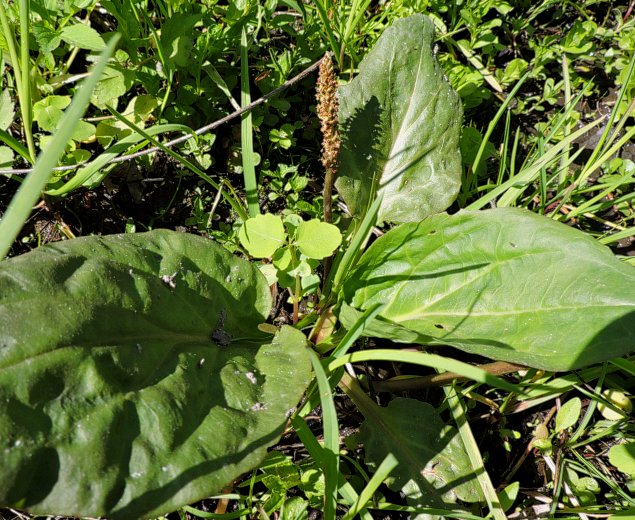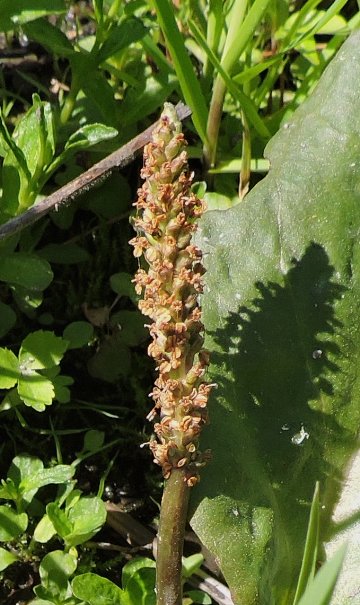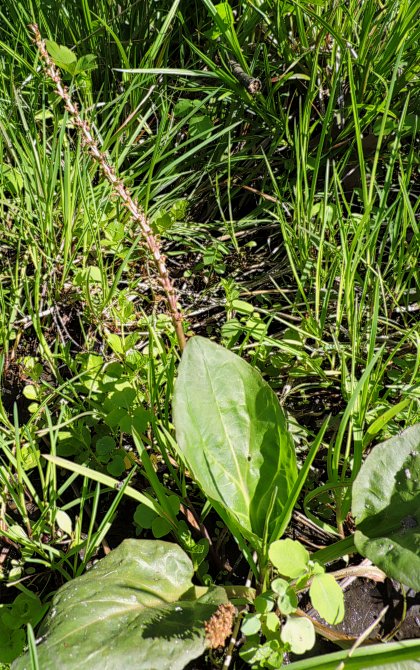Heart-leaved
Plantain
Plantago cordata
Plantain family (Plantaginaceae)
Plantago cordata
Plantain family (Plantaginaceae)
Description:
This is a perennial herbaceous plant that forms a summer rosette of
slightly fleshy basal leaves up to 2' across (rarely wider). Individual
basal leaves are 4–12" (10–30 cm.) long and 2½–8" (6–20 cm.) wide
(rarely larger in size); they are cordate-ovate in shape and smooth to
horizontally undulate along their margins. The leaf surfaces are medium
to dark green and hairless. Leaf venation is pinnate; there is a
central vein and several prominent lateral veins. The latter veins
diverge from the central vein toward the bottom of each leaf, and they
do not run parallel to the leaf margins. The narrow petioles are about
the same length as the leaves; they are green or light purple,
hairless, and concave-convex.

Each fertile plant produces 1-6 flowering stalks up to 20" (50 cm.) in length from the center of the rosette of basal leaves. These flowering stalks are ascending to erect, although they fall over with age. Each flowering stalk consists of a spike of flowers and a naked peduncle below. The flowers are rather congested along the spike during the blooming period, but they become more sparsely distributed along the spike with age. The peduncle (basal stalk) and floral stalk are often light greenish brown and either hairless or covered with very fine short hairs; they become hollow at maturity. Each sessile flower (less than 3 mm. long & across) has 4 green to brown sepals, 4 brown petals, 4 exserted stamens, and a green ovary with a pair of feathery stigmas. The sepals (2–2.5 mm. long) are broadly oval in shape with very narrow outer keels; their upper margins are rough-membranous. The petals are rough-membranous with reflexed or spreading lobes; they are fused together at the base and persistent.

The blooming period occurs during mid- to late spring (rarely later). Individual flowering spikes bloom gradually from the bottom to the top, lasting about 3–4 weeks. The flowers are cross-pollinated by the wind. In the absence of cross-pollination, the flowers are self-fertile. Afterwards, the flowers are replaced by seed capsules that mature during the early summer (rarely later). Mature seed capsules are 5–6 mm. long, ovoid in shape, and circumsessile along the middle (where they later split into two halves to release their seeds). Each seed capsule contains 2 seeds; the seeds are often distributed by water. Individual seeds are 3–4 mm. long, dark brown, smooth, and ellipsoid in shape with a pit on the inner face. The seeds become mucilaginous and sticky when they are wet. The root system consists of a stout corky caudex with several fleshy fibrous roots below; the caudex is often partially hollow. This plant reproduces occasionally by forming clonal offsets that eventually become separated from the mother plant. This plant also produces a small winter rosette of basal leaves that looks very different from the summer rosette of basal leaves.
Individual basal leaves of a winter rosette are about 2–4" (5–10 cm.)
long, ½–1¼" (1.25–3 cm.) wide, and oblanceolate in shape.
summer rosette of basal leaves.
Individual basal leaves of a winter rosette are about 2–4" (5–10 cm.)
long, ½–1¼" (1.25–3 cm.) wide, and oblanceolate in shape.
Cultivation: The preference is light shade to partial sun, consistently moist to wet conditions (including shallow water, if it is clear), and a neutral to alkaline substrate containing gravel (especially limestone or dolomite), sand, or clay. Plants that grow in too much shade often fail to flower. Locations where competition from other ground vegetation is reduced are preferred. The seeds remain viable for only a short time (up to 3 weeks) and they must be kept moist in order to be remain viable.
Range & Habitat: In Illinois, Heart-leaved Plantain is a rare native plant that is state-listed as endangered. It is uncommon throughout its range in eastern United States and appears to be declining in abundance. This plant has been found in several scattered counties in Illinois, but it no longer occurs at some of these locations. Habitats include lower banks and shallow water of clear-running streams in wooded areas, gravel bars and sand bars along clear-running streams in wooded areas, semi-shaded seeps and springs, and swampy woods. The rocky substrate in many of these habitats is dolomite or limestone (especially the former). Heart-leaved Plantain is a very conservative species that is found in high quality natural areas. It does not tolerate muddy water from field run-off or clear-cutting of trees and the vacillating water levels that result from such disturbance. Algal blooms in streams from fertilizer run-off can entrap the seeds and impair their ability to germinate and establish themselves as seedlings. This plant is also vulnerable to herbicide run-off from lawns and agricultural fields.
Faunal Associations: The foliage is eaten by slug and snails, which can kill seedlings. Insects that feed on other plantains (Plantago spp.) may also feed on this species. The slightly fleshy foliage of this plant is readily eaten by deer, horses, and cattle, especially when it is young. Because the seeds become sticky when they are wet, these grazing animals may spread the seeds to new locations.
Photographic Location: A sunny damp area in Fayette County, Illinois. The photos were taken by Keith Horn (Copyright © 2018).

Comments: Heart-leaved Plantain (Plantago cordata) is the largest plantain (Plantago spp.) in the United States. Summer basal leaves up to 2½' (75 cm.) long have been reported in the literature. Unfortunately, this interesting plant has become rare. It is similar in appearance to two weedy plantains, Plantago major (Common Plantain) and Plantago rugelii (Black-seeded Plantain), but larger in size. Heart-leaved Plantain usually blooms earlier in the year than these latter two species. The major lateral veins of its leaves are not parallel to the leaf margins, unlike those of the two weedy plantains, and its seed capsules contain only 2 seeds, rather than 4–30 seeds per capsule. Other plantain species (Plantago spp.) that occur in Illinois are smaller plants with more narrow leaves. For more information about Heart-leaved Plantain, see the discussion by Hill (2007).

Each fertile plant produces 1-6 flowering stalks up to 20" (50 cm.) in length from the center of the rosette of basal leaves. These flowering stalks are ascending to erect, although they fall over with age. Each flowering stalk consists of a spike of flowers and a naked peduncle below. The flowers are rather congested along the spike during the blooming period, but they become more sparsely distributed along the spike with age. The peduncle (basal stalk) and floral stalk are often light greenish brown and either hairless or covered with very fine short hairs; they become hollow at maturity. Each sessile flower (less than 3 mm. long & across) has 4 green to brown sepals, 4 brown petals, 4 exserted stamens, and a green ovary with a pair of feathery stigmas. The sepals (2–2.5 mm. long) are broadly oval in shape with very narrow outer keels; their upper margins are rough-membranous. The petals are rough-membranous with reflexed or spreading lobes; they are fused together at the base and persistent.

The blooming period occurs during mid- to late spring (rarely later). Individual flowering spikes bloom gradually from the bottom to the top, lasting about 3–4 weeks. The flowers are cross-pollinated by the wind. In the absence of cross-pollination, the flowers are self-fertile. Afterwards, the flowers are replaced by seed capsules that mature during the early summer (rarely later). Mature seed capsules are 5–6 mm. long, ovoid in shape, and circumsessile along the middle (where they later split into two halves to release their seeds). Each seed capsule contains 2 seeds; the seeds are often distributed by water. Individual seeds are 3–4 mm. long, dark brown, smooth, and ellipsoid in shape with a pit on the inner face. The seeds become mucilaginous and sticky when they are wet. The root system consists of a stout corky caudex with several fleshy fibrous roots below; the caudex is often partially hollow. This plant reproduces occasionally by forming clonal offsets that eventually become separated from the mother plant. This plant also produces a small winter rosette of basal leaves that looks very different from the
 summer rosette of basal leaves.
Individual basal leaves of a winter rosette are about 2–4" (5–10 cm.)
long, ½–1¼" (1.25–3 cm.) wide, and oblanceolate in shape.
summer rosette of basal leaves.
Individual basal leaves of a winter rosette are about 2–4" (5–10 cm.)
long, ½–1¼" (1.25–3 cm.) wide, and oblanceolate in shape.Cultivation: The preference is light shade to partial sun, consistently moist to wet conditions (including shallow water, if it is clear), and a neutral to alkaline substrate containing gravel (especially limestone or dolomite), sand, or clay. Plants that grow in too much shade often fail to flower. Locations where competition from other ground vegetation is reduced are preferred. The seeds remain viable for only a short time (up to 3 weeks) and they must be kept moist in order to be remain viable.
Range & Habitat: In Illinois, Heart-leaved Plantain is a rare native plant that is state-listed as endangered. It is uncommon throughout its range in eastern United States and appears to be declining in abundance. This plant has been found in several scattered counties in Illinois, but it no longer occurs at some of these locations. Habitats include lower banks and shallow water of clear-running streams in wooded areas, gravel bars and sand bars along clear-running streams in wooded areas, semi-shaded seeps and springs, and swampy woods. The rocky substrate in many of these habitats is dolomite or limestone (especially the former). Heart-leaved Plantain is a very conservative species that is found in high quality natural areas. It does not tolerate muddy water from field run-off or clear-cutting of trees and the vacillating water levels that result from such disturbance. Algal blooms in streams from fertilizer run-off can entrap the seeds and impair their ability to germinate and establish themselves as seedlings. This plant is also vulnerable to herbicide run-off from lawns and agricultural fields.
Faunal Associations: The foliage is eaten by slug and snails, which can kill seedlings. Insects that feed on other plantains (Plantago spp.) may also feed on this species. The slightly fleshy foliage of this plant is readily eaten by deer, horses, and cattle, especially when it is young. Because the seeds become sticky when they are wet, these grazing animals may spread the seeds to new locations.
Photographic Location: A sunny damp area in Fayette County, Illinois. The photos were taken by Keith Horn (Copyright © 2018).

Comments: Heart-leaved Plantain (Plantago cordata) is the largest plantain (Plantago spp.) in the United States. Summer basal leaves up to 2½' (75 cm.) long have been reported in the literature. Unfortunately, this interesting plant has become rare. It is similar in appearance to two weedy plantains, Plantago major (Common Plantain) and Plantago rugelii (Black-seeded Plantain), but larger in size. Heart-leaved Plantain usually blooms earlier in the year than these latter two species. The major lateral veins of its leaves are not parallel to the leaf margins, unlike those of the two weedy plantains, and its seed capsules contain only 2 seeds, rather than 4–30 seeds per capsule. Other plantain species (Plantago spp.) that occur in Illinois are smaller plants with more narrow leaves. For more information about Heart-leaved Plantain, see the discussion by Hill (2007).